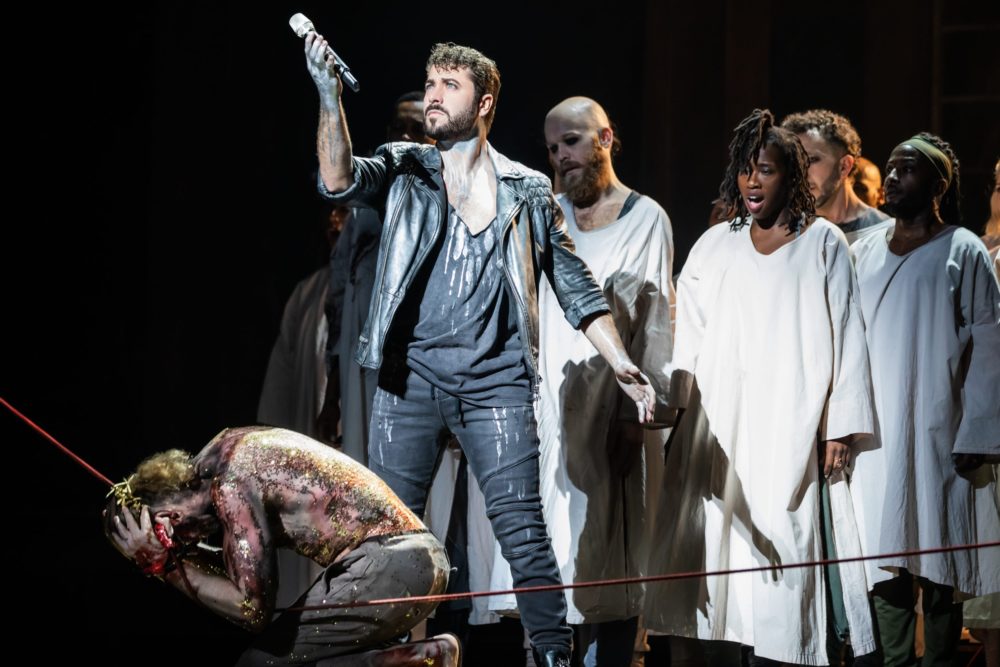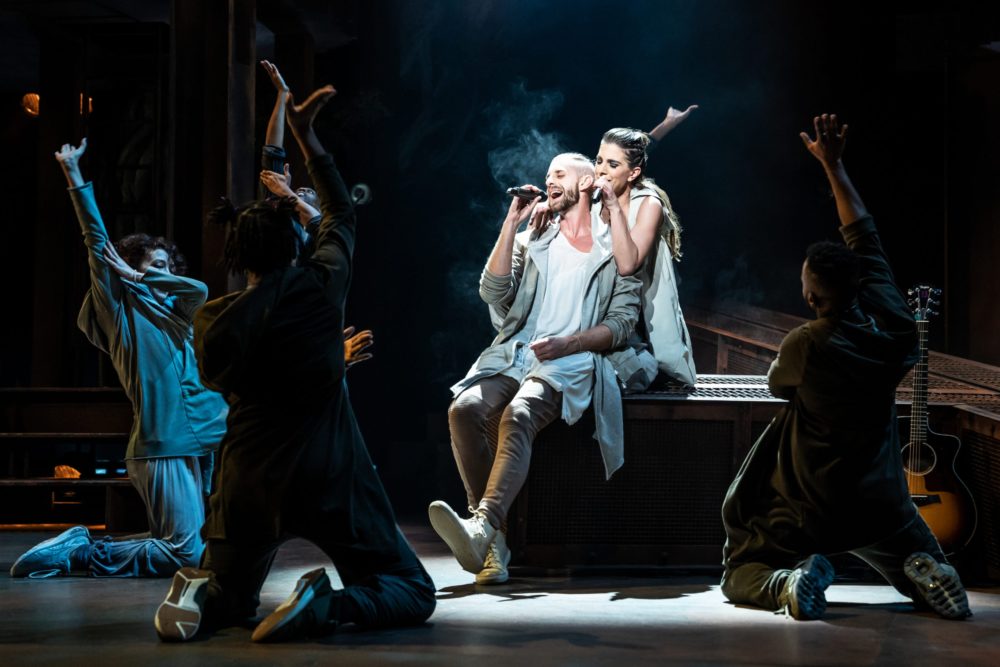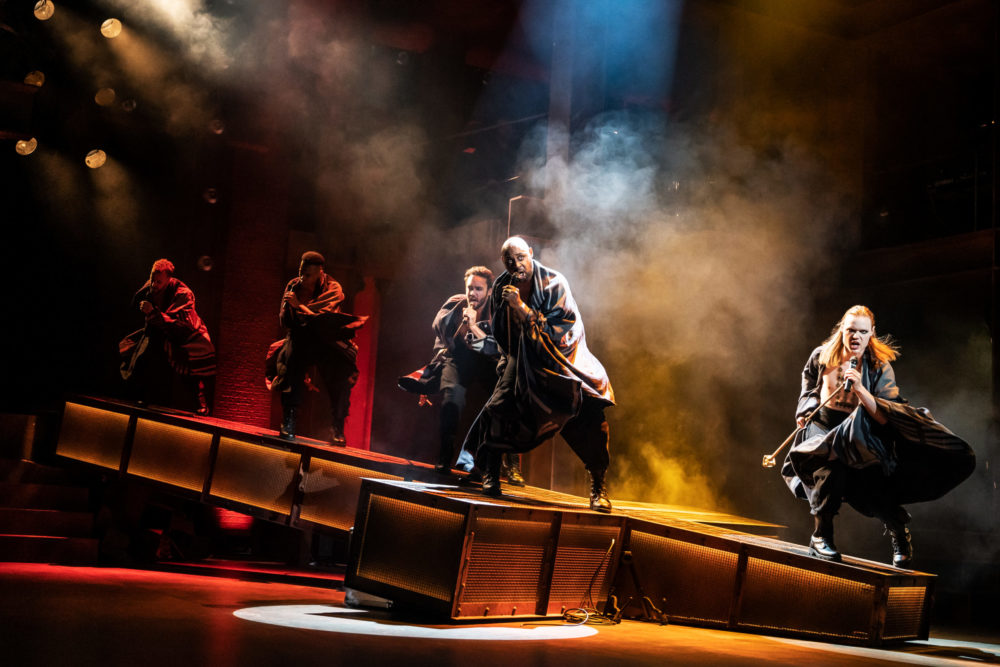It’s never a bad time to revisit good ole Jesus Christ Superstar. Now, 50 years after it first shattered expectations about what a musical could sound like, might be the best time of all.

The 50th-anniversary national tour now rocking the Kennedy Center offers such a fresh, yet timeless, take on the seminal musical that it is tempting to label it unmissable. Much of the production’s success rests on Timothy Sheader’s shape-shifting direction and Drew McOnie’s frenetic, synchronized choreography. The production, which originated in Britain, won the Olivier Award for best musical revival in 2016. After a two-year delay due to COVID, DC audiences are finally getting their chance to see “what’s the buzz” all about.
Jesus Christ Superstar burst onto the scene as a concept album in 1970, released when composer Andrew Lloyd Webber and lyricist Tim Rice were still in college. By 1971, record executives had shut down over 20 unlicensed stage productions that had popped up across the U.S. and Canada before the show finally opened officially on Broadway later that year. People couldn’t get enough of the show’s electric sounds and controversial retelling of Judas’ betrayal of Jesus.
Fifty years later, Sheader’s production manages to simultaneously embrace the rock-concert vibe that Webber and Rice originally intended for the musical, and also feel incredibly theatrical. An ensemble of frenetic, synchronized dancers forms the visual centerpiece of the production. The three principal characters, Jesus, Judas, and Mary, sing into handheld microphones, giving the show a sense of intimacy, as if the audience were privy to a recounting of history set to music. And the band, the musical jewel of the show, is wisely placed directly on stage, on the upper level of metal scaffolding that crosses the entire rear of the stage. This allows audiences to bop along with the musicians as they storm headlong through a score that starts with an iconic guitar solo (by Mike Frederick) and quickly blooms into the Overture that has become one of the most beloved and recognizable works of music in the musical theater canon.
The result is a production that feels extremely current and also deeply rooted in the 1970s musical zeitgeist from which it emerged.
Among the lead performers, Jenna Rubaii stands out as the biblical Mary Magdalene, who comforts and supports Jesus. Mary’s three ballads provide soft spots in an otherwise hard-hitting musical, and Rubaii knocks them gently out of the park. The classic tunes “Everything’s Alright,” “I Don’t Know How to Love Him,” and “Could We Start Again Please?” all find safe harbor in her folk-tinged voice and magnetic stage presence.

Faring less well are Aaron LaVigne as Jesus and Omar Lopez-Cepero as Judas. Both men clearly have the chops for the belt-heavy roles, but Lopez-Cepero misses several opportunities to crank up the angst his character should be feeling, and both sing with the detachment of someone performing a role rather than inhabiting it.
The supporting cast mostly comprises Jesus’ disciples and the various government officials who determine his ultimate fate. These officials march on and off stage on a large metal cross that lies at an angle across the stage. The fallen cross serves as a runway, a dance floor, and the table for the Last Supper, its constant presence an ominous reminder of its ultimate intended use.
As Annas and Caiaphas, the officials who bribe Judas into giving away Jesus’ whereabouts, Tyce Green and Alvin Crawford complement each other both vocally and thematically, forming a yin and yang of temptation. Green lures Judas toward betrayal with his cloying tenor (“Your help in this matter won’t go unrewarded…”) and Crawford seals the deal with his reverberating bass (“We’ll pay you in silver, cash on the nail…”). Flanked by soldiers, the pair stand on the cross, caressing and humping five-foot-tall mic stands that double as scepters. With their bare chests (and Green’s flowing hair), the pair brings to mind a ’70s glam rock band infused with sinister echoes of military might.

Tommy Sherlock and Paul Louis Lessard also get star turns as government officials. Sherlock is contemplative as Pilate, ruminating over the responsibility of leadership in the song “Pilate’s Dream,” and rising to anger when Jesus refuses to answer his questions. Lessard provides comic relief in the showy “Herod’s Song,” in which he mocks Jesus’ purported powers (“Prove to me that you’re divine, change my water into wine!”) in a charismatic solo performance.
Herod’s flashy gold cape is one of the production’s few departures from a subdued color palette, a palette that starts with comfortable costumes that look borrowed from a post-apocalyptic Lululemon, where Biblical desert-dwellers spend their days dancing to electric guitars. Tom Scutt’s costumes and scenic design give the show a Biblical feel while never feeling performative. The only other pop of color in the production is the glitter that is flung at Jesus in time to the music as he is flogged 39 syncopated times. (Condolences to the stage crew that has to clean up each night.) Lee Curran’s expert lighting design heightens the onstage drama as beams of light criss-cross the stage like laser beams. Floodlights aimed from the back to the front of the stage illuminate the performers from behind, bringing to mind the lighting at a police interrogation.
When I was in college, my best friend and I saw Jesus Christ Superstar whenever we could. She was Catholic and religious, I was not. But for very different reasons, we both came away from Jesus Christ Superstar feeling like we had just had a religious experience. Now, as then, Jesus Christ Superstar is taking audiences to celestial heights.
Running Time: One hour 35 minutes with no intermission.
Jesus Christ Superstar plays through March 13, 2022, at the Kennedy Center Opera House – 2700 F Street NW, Washington, DC. For tickets ($45–$185), call the box office at (202) 467-4600 or go online.
The Jesus Christ Superstar program is online here.
COVID Safety: Masks and proof of vaccination are required. Kennedy Center’s complete COVID Safety Plan is here.





I think we saw different shows – for the first time in my 20 year history of attending events at the Kennedy Center I walked out. It has the biggest waste of money to date. The adaptation was marginal at best. The overdone use of glitter was obnoxious. The use of microphones and cords in a historic piece was, at best, distracting. The set design was the only positive I had about the entire show. This director should not be allowed back and needs to have a much smaller glitter budget. JCS should be a powerful and entertaining piece yet it lacked any sparkle – from the choreography to the costumes…i want my time back…
You are definitely not the first person I have heard from who didn’t like it! When we walked out, I turned to my husband and said “wasn’t it wonderful?” He replied “ummmm…. I couldn’t understand anything they said.” Personally, the creative choices really worked for me. I loved the strong dance element to the show and I thought having microphones in the hands of the main characters was a clever nod to the fact that JCS was originally a rock concept album. I DID feel bad for whoever has to clean up all that glitter, but to me, it was a clever way to insert a bit of unexpected drama. I know that this show did not click for a lot of DC audience members even though it won the Olivier Award in London before it went on tour. It would be interesting to be able to see the London and tour versions side by side to see if they differ at all.
I also left before it was over. This show was a waste of time (and money) for me. Basically, it isn’t an opera, because in an opera the performers portray characters and actually do some acting. In this production, the singers just belt out songs as if they were in a rock concert, with no effort made to portray a character (even the singing lacked emotion – perhaps in part because it was over-amplified). I was never drawn into the story and felt no connection with anyone on stage. The dancers were annoying; the choreography didn’t seem to have much to do with anything, and presumably existed to make the lack of acting less noticeable. The costumes were ridiculous, to the point of it looking like the costume designer thought that the costumes were for a comedy rather a serious tragedy.
I’m with Lisa and Jeffrey. Of the 75+ performances I’ve attended at the Kennedy Center, this was one of only two I thought was awful. And this was more awful than the other one.
The choreography can only be described as a hot mess, with too many people, doing too many things, often in too much of a hurry, and too often with herky-jerky-bordering-on-spasmodic movements that did not in any way fit the mood Jesus’s final few days. Had they been performing separately in a dance show, it would have been different, as they were talented dancers, but none of the people I went with or since spoke to could figure out what in the world the chroreographer was thinking. (And that’s before you get to Ultra-Intense Dance Girl, whose ill-timed paroxysms made me want to rush her some anti-seizure medication.)
The prop microphones and cords were also a distraction, and had the corollary effect of inhibiting the artists’ movements and expressions, which were already lacking. So too was having Jesus tote around a guitar he never played, and never seemed quite sure what to do with.
You’d think Ultra-Intense Convulsive Dancer would be the most ill-fitting and grimace-inducing part of the show. But nope, the director, who like the choreographer deserves 39 lashes more than Jesus ever did, managed two even greater forehead-slappers: first by having the palace officials stroke their microphone stands erogenously while plotting Jesus’s arrest (cuz who doesn’t have the urge to rub one out during a crucifixion?), and then by having Herod suit up in drag, with leotards and 3″ eyelashes, and essentially butchering one of the best songs and key moments of the show.
Like too much of the show, it left you wondering, “why? Why take an iconic show and butcher it this way?”
On the positive side, the set design was excellent, as was the band, and having the band a visible part of the set was a great move. Pilate was excellent, and unlike some of the other performers was aware there was an audience hoping to connect with him. Mary had some strong moments, and Caiphus was excellent, too, though for some reason the director several times had him blocking the view of those behind him. Simon was also good.
I suppose it’s odd to get this far into a summary without mentioning the main two characters. That’s because Jesus was okay — nothing more, nothing less — and we had the understudy during our performance, so for all I know he was doing it for the first time. Which brings us to Judas, on whom the show’s success depends since he needs to carry it both at the beginning and the end. This Judas had his moments — he certainly could sing well — but he rephrased and re-inflected many of the lyrics, and usually not for the better. Like Jesus and several other performers, he didn’t seem to connect much with the audience.
I went to this show super-psyched, excited to revive a show I first saw 48 years ago. I left thinking it had failed the most important test of any performance: would I have gone had I known beforehand how it would turn out. Sadly, the answer on this one is, “no way.” This “modern adaptation” should have come with a warning label.
My wife and I attended the April 12, 2022 performance in Dallas. Mary Magdalene was the stand out performer in our opinion. She has a beautiful voice, and everything about her performance was great. She should probably coach most of the other singers in how to properly enunciate their lyrics. We could not understand/decipher any of the vocals from Jesus or Judas. They could have been singing in Latin, it was awful, and painful to sit through. “Queen” Herod was way over the top, and one of the dumbest ideas we have seen make to the stage. On our 90 minute drive home, we came to the conclusion this was the worst stage performance we ever attended. We are in our 60’s and have been to a lot of stage productions.
We just saw this in Fort Worth and loved it so much we saw it twice. The leads are incredibly talented singers with Omar Lopez-Ceprero the most mesmerizing, LaVigne powerful, Rubaii rich and fluid. Choreography was fresh, riveting, dynamic. Having seen many, many shows on Broadway over the years, this incarnation of JCS ranks with the best.